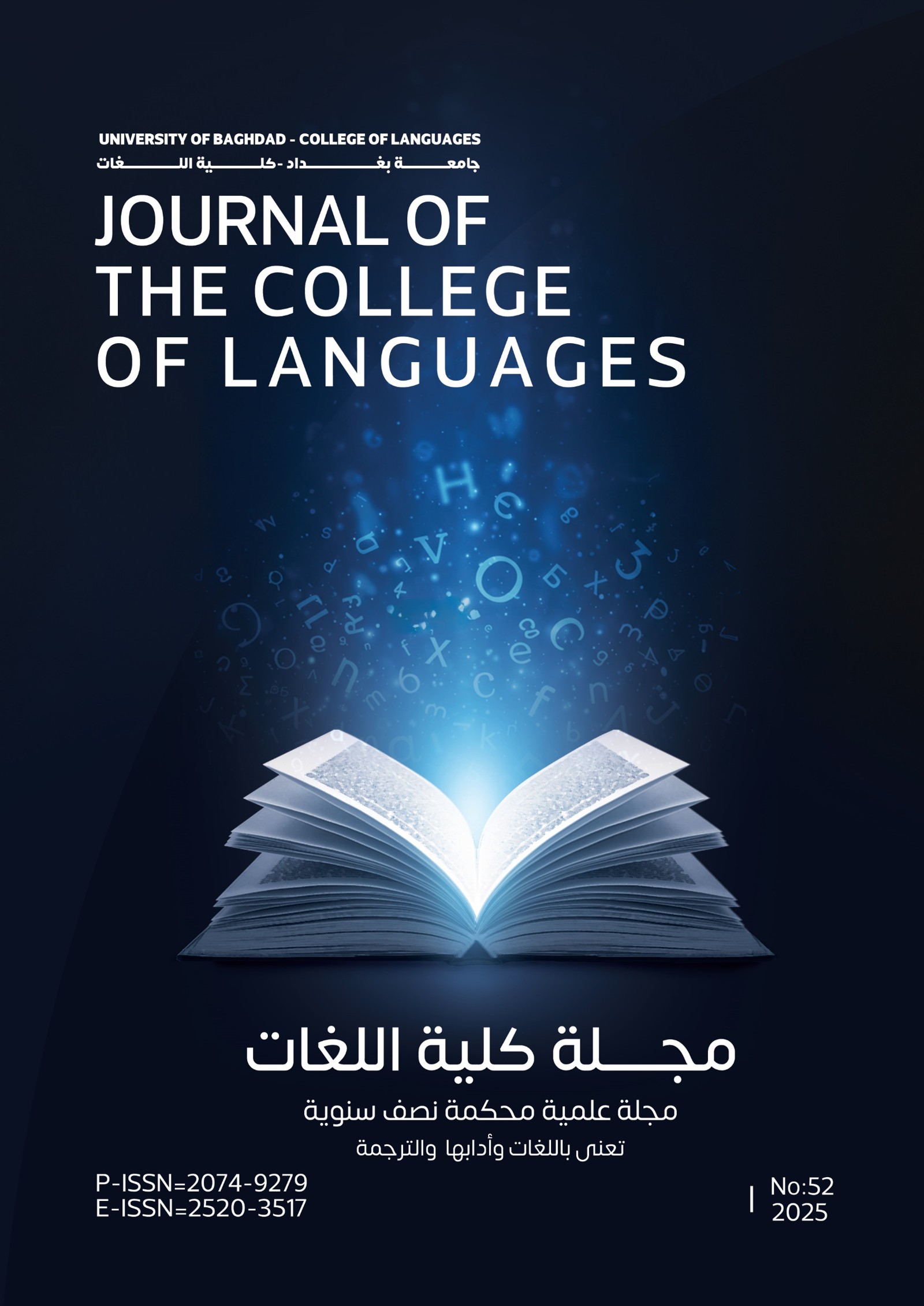A comparative study of the pivotal characters in the novel "Al-Shahz" and the script "Hamoon"
بررسی تطبیقی شخصیت¬های محوری در رمان «الشحّاذ» و فیلمنامۀ «هامون»
DOI:
https://doi.org/10.36586/jcl.2.2022.0.46.0275Keywords:
ادبیات تطبیقی، الشحّاذ، عمر الحمزاوی، حمید هامون، پوچ گرایی.Abstract
The novel is the revelation of the attitudes of every age. And the writers do not know the winner of their stroke to express these events، The research has been working on a descriptive-analytical approach based on the American Comparative School، Al-Shahez's novel explores the work of the nobly and the film by Hamoun by Dariush Mehrjui By relying on the main characters of these two narratives, they depict a picture of Egypt and Iran From the symbolic lines of these works. In fact, the authors of this research have tried to initiate the introduction and analysis of these two works In fact, the authors of this research have tried to initiate the introduction and analysis of these two works.
The results of the research show that Najib protected his literary and semantic literatures, "Al-Shahaz" and Dariush Mehrjui, in the film "Hamoon" They describe the lives of Third World intellectuals In the young age, they were hard-hearted and repulsive revolutionaries, but regretted and disillusioned at midnight. The main characters of these two novels, "Omar al-Hamsawi" and "Hamid Hamoon" are very enthusiastic at the beginning of the journey, but the process of life goes away from their socialist thoughts And suddenly they go to the absurd. They are confronted with events that are more likely to affect the social and psychological contradictions of these two characters.
چکیده
باتوجه به اینکه رمان بازگوکننده عینی احوالات سیاسی و اجتماعی و فرهنگی و... هر عصر به شمار میرود و نویسندگان برای بیان این وقایع سلاحی برندهتر از قلم خویش نمیشناسند، پژوهش مذکور تلاش کرده است با رویکرد توصیفی- تحلیلی و بر اساس مکتب تطبیقی آمریکایی، رمان الشحّاذ اثر نجیب محفوظ و فیلمنامۀ هامون نوشتۀ داریوش مهرجویی را مورد بررسی قرار دهد تا با تکیه بر شخصیت های اصلی این دو روایت تصویری از سیمای مصر و ایران را از لابهلای سطور نمادین این آثار به نمایش بگذارد. در واقع نگارندگان این پژوهش کوشیدهاند که در ابتدا به معرفی و تحلیل این دو اثر بپردازند و در ادامه شباهت های میان شخصیت های محوری آن را بیان کنند.
برآیند تحقیق نشان میدهد که نجیب محفوظ در اثر ادبی و نیمهشناختی خویش «الشحّاذ» و داریوش مهرجویی در فیلمنامۀ «هامون» به شرح زندگی روشنفکران جهان سوم پرداختهاند که در جوانی از انقلابیون سرسخت وآرمانخواه بوده اما در میانسالی پشیمان و سرخورده شدهاند. شخصیتهای اصلی این دو رمان یعنی »عمرالحمزاوی« و «حمید هامون» در ابتدای راه بسیار پرشورند اما در ادامه روند زندگی از افکار سوسیالیستی خود دست میشویند و یکباره به پوچی میرسند. آنها در این فرآیند با اتفاقاتی روبهرو میشوند که بیشازپیش بر تناقضات اجتماعی و روانی این دو شخصیت تأثیرمیگذارند.
References
A: Books
Ahmadi, Babak (1390h); Intellectual Work, Ch 4, Tehran: Markaz Publishing.
Al-Rubaie, Mahmoud (1974); His reading of the novel, Cairo: House of Knowledge.
Al-Qadi, Muhammad et al. (2010); Narrative Dictionary, 1st Edition, International Association of Independent Publishers, several countries.
Azarnoosh, Azartash (1391h); Contemporary Arabic-Persian Culture Based on Arabic-English Culture, Tehran: Ney Publishing.
Anis, Ibrahim; Montaser Al-Ghair (1972); Al-Waseet Dictionary, Cairo: The Islamic Library.
Bagheri, Hamid (2015); Mehrjui and Jung Cinema (Fredity in the films of Hamoon, Banoo, Peri, and the Pear Tree), First Edition, Tehran: Hermes Publications.
Dehkhoda, Ali Akbar (1377h); Dictionary, Tehran: Institute of Publishing and Printing, University of Tehran.
Farag, Nabil, 1990, Naguib Mahfouz, "His Life and Literature" first edition, Egypt: The Egyptian Public Authority for Books.
Ibrahiman, Seyed Hossein (2002); Anthropology (Islam-Existentialism), First Edition, Tehran: Maaref Publishing Institute.
Jawaher Kalam - Mohammad (1372h); A Look at Contemporary Arab Short Stories, First Edition, Tehran: Javaherkalam.
Khaled-Ashour (2008); Searching for Zaabalawi, the critical movement on Naguib Mahfouz, Cairo: The Egyptian General Organization for Writers.
Kheiri, Mahdieh, 1390h, Works and Principles of the Philosophy of Existentialism in Najib Mahfouz's works based on the novel "Olat Haratna" Master Thesis, Faculty of Humanities, Tarbiat Modares University.
Mohammad Saeed, Fatemeh Al-Zahra (1378h); Symbolism in the works of Najib Mahfouz, translated by Dr. Najmeh Rajaei, first edition. Mashhad: Ferdowsi University.
Mahfouz, Naguib (1965); The Beggar, Egypt: The Library of Egypt and Dar Misr for Printing.
Mahfouz, Najib (1388h); Beggar (Al-Shahad), translated by Mohammad Dehghani, Tehran: Niloufar.
Marx, Karl (1382h); Economic and Philosophical Manuscripts, translated by Hassan Mortazavi, third edition, Tehran: Agah.
Muhammad Al-Amin Al-Talba, Muhammad Salem (2008), Levels of Language in Contemporary Arabic Narration, An Applied Theory Study of Semantic (Narrative), 1st Edition, Beirut: The Arab Spread.
Mehrjui, Dariush (1371h); Hamoon Screenplay, First Edition, Tehran: Zamaneh Publications.
Neda, Taha (1383h); Comparative Literature (Comparative Literature), translated by Hadi Manzam, Tehran: Nashr-e Ney.
Sotoudeh, Hedayat and Mozaffaruddin Shahbazi (2009); Sociology in Literature, Second Edition, Tehran: Nedaye Ariana.
Saeed, Edward (1391h); The role of the intellectual translated by Hamid Azdanloo, Ch 4, Tehran: Ney Publishing 2012.
Shariati, Ali (1379h); Unconscious Man, Volume 4, Tehran: Qalam Publications.
Shariati, Ali (2015); Collection of works (return to oneself), Mashhad: Sepideh Bavaran.
Tarabishi, George (1988); God in Naguib Mahfouz's Symbolic Journey, 3rd Edition, Beirut: Dar Al-Tali'a for Printing and Publishing.
Zaraati. Nasser (1375h); Dariush Mehrjoui Critique of works from Diamond 33 to Hamoon, Tehran :. Hermes Publications.
Zetoni, Latif (2002); Dictionary of Critical Narrative Terms, Vol. 1, Beirut: Nastron Lebanon School.
B: magazines
Baghjari, Kamal,. Bashiri Ali (1394h); "Analysis of the Narrative of the Novel (Al-Shahad) Beggar by Najib Mahfouz", Journal of Arabic Language and Literature (Mashhad Faculty of Literature and Humanities), pp. 57-75.
Heidari, Mahmoud and Fathi Fatah, Zabihullah (1393h); "Study of the principles of surrealism in the story of" Al-Shahad "by Najib Mahfouz", Journal of Arabic Language and Literature (Mashhad Faculty of Literature and Humanities), pp. 63-72.
Yoosuf, Abbas Dawi, An Analytical Study of Viewpoint in Parsi Pour's and Ar-Rikabi's Novels: The Dog and the Long Nightand Alibaba's Sad Night as Examples", Journal of the College of Languages NO/ 40. Baghdad / 2019.
Downloads
Published
Issue
Section
License
Copyright (c) 2022 Journal of the College of Languages (JCL)

This work is licensed under a Creative Commons Attribution 4.0 International License.








